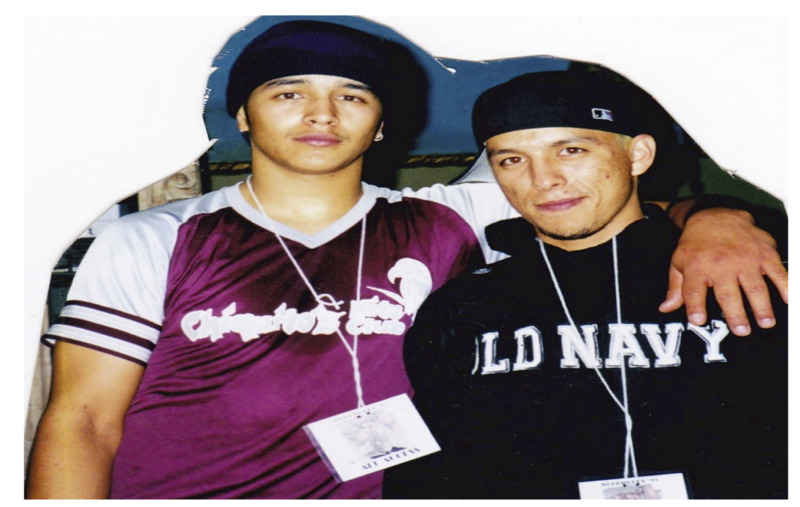Ch. 1: Climax/Soul Control Pre-History
The Begining (even if they did not know it yet)
In the mid-1990s, Eric Costello was a high school student in Southeast Fresno looking to find his niche in the local teen social order. He found some satisfaction in youth sports but his attention increasingly was pulled toward b-boying, a style of dance that blended artistry with athleticism. Like many Fresno youth his age, he had minimal and sporadic exposure to the dance, mostly from friends, family members, and the occasional VHS tape circulating around the neighborhood. Initially, Costello’s b-boying was confined to the comfort and anonymity of his bedroom and maybe the occasional family gathering; however, once at Roosevelt High School he saw a friend from his youth sports days, Pablo Flores, taking on all comers during lunch-time b-boy battles and serving them with moves that most had not even conceived of much less mastered. Costello was entranced. Even though Costello did not know so at the time, that moment of awe, of recognizing that passion and dedication can lead to innovation, of learning about the existence of a community of like-minded youth, and of wanting to be part of something that made people pay attention, set in motion a ripple effect that fundamentally changed Fresno by creating a cultural legacy that lives on today. We will get to that legacy shortly but before we do so, we need another piece of backstory.
Charles and Pablo
In the early 1990s a ten-year-old boy sat on the roof of his grandmother’s home in Southeast Fresno, surveying the landscape of the Butler Park neighborhood below; his eyes were drawn to the sight of a boy his age three houses down puncturing the sky with successive waves of bounces, twists, and flips off of a mini-trampoline. The cliché historian angle here is to say that multiple histories intertwined in that moment to entice the boy off of the roof; there was the intimate history of grief unfairly heaved on the shoulders of the ten-year old on the roof following his father’s tragic death; the macro history of migration, geography, and neglect at the heart of working-class Butler Park; histories yet to be written of two Butler Park boys who crossed neighborhood boundaries and global borders to put Fresno on the b-boy map.
While all off that is true, the reality is that the boy was drawn off the roof because seeing boys your age puncture the sky is pretty amazing; so the boy bounded down the street to meet the mysterious, gravity-defying figure. Two things happened when the boy on the roof found the boy puncturing the sky: 1.The boy on the roof learned to do a front flip off of a mini-trampoline and 2. Charles Montgomery met Pablo Flores.
Fresno Hmong B-boy Crews
By the time Montgomery and Flores entered middle school (at Kings Canyon and Sequoia, respectively), they learned from movies like Breakin’ and Beat Street that they could blend the raw athleticism on display during that initial meeting with hip-hop rhythm and competition; soon, they took to calling themselves b-boys. Eventually, Montgomery and Flores found other b-boys, notably, working-class children of Hmong refugees trying to windmill and headspin their way out of inter-generational trauma and towards a sense of community in occasionally hostile environments. Starting in middle school and continuing into Roosevelt High School, Montgomery and Flores began to hone their skills in predominantly Hmong crews, Dancing in Style (DIS) and Smurfs respectively. These crews had already begun to internalize the local "power move" tradition started by their b-boy elders (and often their older brothers) in earlier predominantly Hmong b-boy crews like the Bumz (learn more about the Bumz in the Bumz exhibit), a tradition that perfectly suited for the two Butler Park boys who met mastering flips on a trampoline.
Ideally, the story of b-boy crews made up of Hmong children of refugees and working-class youth of Creole, Mexican, and Filipino backgrounds would be the climax (pun intended) of this story: a tale of multi-ethnic friendships smashing racism to the funky samples of Clyde Stubblefield’s drums. Some of this is true; however, like so many other inner-city environments across the United States, Southeast Fresno in general and Butler Park in particular were neglected communities with few job opportunities or resources and plenty of gangs seeking to fill those voids. In real world terms, for Montgomery and Flores these conditions meant conversations with Mexican Bulldog gang members questioning their loyalty for hanging out with “Asians.” At the same time, crossing multiple gang boundaries while walking to Holmes Playground for a practice session meant a variety of suspicious stares and, on at least one occasion, a pulled pistol, from Hmong gang members. The reality of the story of a b-boy crew made up of Hmong children of refugees and working-class youth of Creole, Mexican, and Filipino backgrounds, then, is that the complex intersections of race, ethnicity, and gang-affiliation made such relationships tricky, if not outright dangerous.
